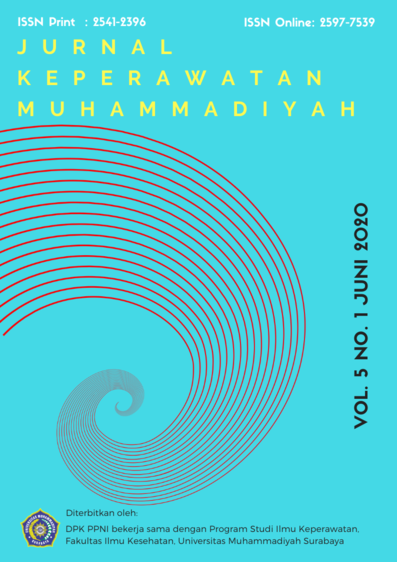Peningkatan Pengetahuan dan Keterampilan Pengukuran Tekanan Cuff Pipa Endotrakeal Perawat Intensif Menggunakan Metode Simulasi dan Demonstrasi
DOI:
https://doi.org/10.30651/jkm.v5i1.3274Keywords:
Skills, Knowledge, Training, Endotracheal Tube Cuff PressureAbstract
Background: Maintaining cuff pressure in the ideal range is the responsibility of nurse. This is needed to prevent the occurrence of complications caused by cuff pressure that is not ideal such as ischemia in the trachea and micro-aspiration.
Objective: this study identified the effect of training toward nurse’s knowledge and skills intensive care unit in measuring endotrakeal tube cuff pressure
Method: This study used the quas experiment design with the pre-posttest method without control group design and analyzed statistically using the Wilcoxon test.
Result: The results of the research conducted were twelve nurses in the intensive care unit at the regional general hospital in dr. Soedarso Pontianak showed a significant difference in knowledge (p 0.002, α 0.05) and skills (p 0.002, α 0.05) before and after training in endotracheal tube cuff pressure training.
References
Departemen Kesehatan RI, (2006). Standar Pelayanan Keperawatan di Intensif Care Unit. Jakarta: Direktorat Keperawatan dan Keteknisan Medik
Cunha, E.L.M., Sales, R.D., Araujo, Z.T.S., Gomes, G.C., Mendes, C.L., Dos Santos, H.H., et. al. (2017). Measurement reliability of endotracheal tubes cuff pressure between industrial and handmade devices. Manual Therapy, Posturology & Rehabilitation Journal. 15; 453.
Fulbrook, P. (2003). Developing best practice in critical care nursing: knowledge, evidence and practice. Nursing in Critical Care. 8(3); 96-102.
Ghafouri, H.M., Saeeidi, H., Yasinzadeh, M., Famouri, S., Modirian, E. (2012). Excessive endotracheal tube cuff pressure: Is there any difference between emergency physicians and anesthesiologists. Signa Vitae.7 (2);17-20.
Godoy, A.C.F.D., Vieira R.J., De Capitani, E.M. (2008). Endotracheal tube cuff pressure alteration after changes in position in patients under mechanical ventilation. Journal Bras Pneumol. 34(5):294-297.
Gilliland, L., Perrie, H., Scribante, J. (2015). Endotracheal tube cuff pressures in adult patients undergoing general anaesthesia in two Johannesburg academic hospitals. Southern African Journal of Anaesthesia and Analgesia. 21(3); 81-84
Goyal, M.J., Kumar, G., Waghray., M.R. (2006). Endotracheal Tube Cuff Pressure Monitoring in Peripheral Hospitals. MJAFI. 62(3): 243-245. Available from: https://www.ncbi.nlm.nih.gov/pmc/articles/PMC4922910/ (Accessed 31 July 2017)
Gunasekera, P., Gratix, A. (2016). Ventilator-associated pneumonia. British Journal of Anaesthesia. 16 (6): 198–202.
Jaillette, E., Leoches, I.M., Artigas, A., Nseir, S. (2014). Optimal care and design of the tracheal cuff in the critically ill patient. Annals of Intensive Care. 4 (7); 2-7.
KostyliovienÄ—, S., VaÅ¡kelytÄ—, A., GrinkeviÄiÅ«tÄ—et, D. (2016). Nurses knowledge of tracheostomy cuff care before and after training. 26(6). 213-218.
Labeau, S.O., Bleiman, M., Rello, J., Vandijck, D.M., Claes, B., Blot, S.I. (2015). Knowledge and management of endotracheal tube cuffs. International Journal of Nursing Studies. 52;498-499.
Lewis, S.L., Dirksen, S.F., Heitkemper, M.M., et al. (2013). Medical Surgical Nursing; Assesment and Management of Clinical Problems. 9th Ed. Velume 2. Mosby Elsevier
Negro, M.S., Barreto, G., Antonelli, R.Q., Baldasso, T.A., Meirelles, L.R., Moreira, M.M., et al. (2014). Effectiveness of the endotracheal tube cuff on the trachea: physical and mechanical aspects. Rev Bras Cir Cardiovasc. 29(4):552-558.
Notoatmodjo, S. (2009). Pendidikan dan Promosi Kesehatan. Jakarta: Rineka Cipta
Sanz, V.T.R., Fuente, R.D.M., Ventana, S.A.B., Martinez, R.M.M. (2015). Cuff pressure control at the intersinve care unit: influence of nursing professionals' training. Enferm Intensiva. 26 (2); 40-45.
Sharghi, N.R., Alami, A., Khosravan, S., Mansoorian, M.R., Elkrami, A. (2015). Academic training and clinical placement problems to achieve nursing competency. Journal of Advances in Medical Education & Professionalism. 3(1); 15-20.
Sue, R.D., Susanto, I. (2003). Long-term complications of artificial airways. Clin Chest Med. 24:457−71.
Talekar, C.R., Udy, A.A., Boots, R.J., Lipman, J., Cook., D. (2014). Tracheal cuff pressure monitoring in the ICU: a literature review and survey of current practice in Queensland. Anaesth Intensive Care. 42(6):761-70.
Tennyson, J., Ford-Webb, T., Weisberg, S., LeBlanc, D. (2016). Endotracheal Tube Cuff Pressures in Patients Intubated Prior to Helicopter EMS Transport. Western Journal of Emergency Medicine. 17 (6); 721-725.
Urden, L. D., Stacy, K.M., Lough, M.E. (2014). Critical Care Nursing Diagnosis and Management. Canada: Elsevier Mosby
Downloads
Published
Issue
Section
License
- Penulis tetap memegang hak atas karyanya dan memberikan hak publikasi pertama kepada jurnal ini yang secara simultan karya tersebut dilisensikan di bawah:Â Creative Commons Attribution-ShareAlike 4.0 International (CC BY-SA 4.0)













